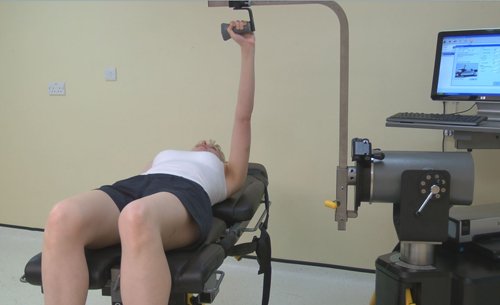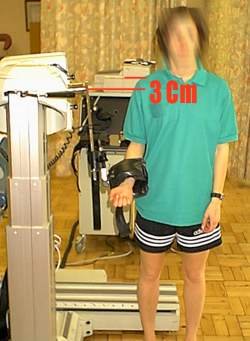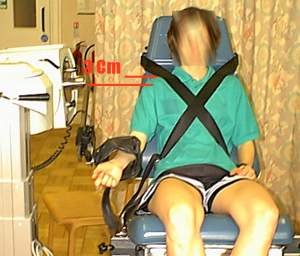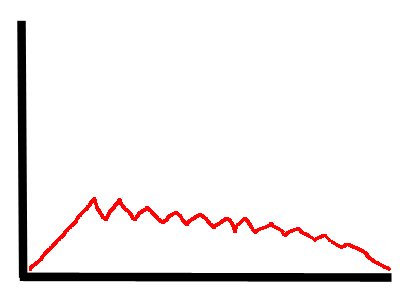There are currently no standard examination positions for flexion and extension of the shoulder. During the movements of the gleno-humeral joint there are always relative movements within the scapulo-thoracic junction. These are usually described as fitting a set of established normal patterns. These must be considered when testing the shoulder. When testing or exercising the shoulder it is vital that the subject has sufficient warm up before performing any movements.
These movements can be performed in either the lying, standing or seated positions.
Lying position:
The most stabilised position for testing flexion but it limits extension unless the subject can get very close to the edge of the bed. Best for research.

To view a set up video see below
Standing position:
In the standing position (see below) stabilization is difficult if not impossible (and probably undesirable). Testing in this position is more functional than that in the seated position.

Seated position:
Alignment is the same as that for the standing position but stabilization usually involves thoracic strapping (see below). Although this position is not as functional. Best for patients.

Stabilisation:
Lying: In the lying position stabilisation normally only involves a pelvic strap to prevent the torso from influencing the results.
Standing: Stabilistion in the standing position is not normally required as this is the most functional position.
Seated: in the seated position stabilisation usually involves a lap belt and chest straps.
Attachments:
There is validity in using a wrist strap (as seen in seated above) rather than a grip handle (as seen in lying above) because this eliminates the influence of the wrist flexors and extensors. Although this may have some face validity it does not translate into real world testing. The hand grip is then always preferable.
Make sure the elbow has a small degree of flexion throughout the range to ensure it’s safety (5 degrees is usually enough).
Axis of rotation:
Regardless of the position of the test the alignment of the instantaneous axis of rotation should be a point roughly 2-3 cms below the inferior lip of the acromial arch. But it has been shown by Walmsley (1993) that the gleno-humeral joint as a whole (never mind its instantaneous axis of rotation) moves by an average of 8cm through range so the need for accuracy must be questioned.
Anatomical zero:
With arm by side of body.
Range of motion:
Generally a large range of motion is chosen for these tests. Generally 0 degrees to 160 and in some cases 180 degrees flexion have been used. Extension is tested less often (most researchers use extension from flexion), however anything from 0-40/60 degrees can be used.
Some testers will test the first 60-90 degrees of flexion with one axis then the remaining motion (which could be described as elevation anyway) with a different axis.
Gravity correction:
As the lever arm can be very long and heavy in these movements setting of gravity correction is essential. In patients gravity elimination (Humac Norm) can be very beneficial to reduce ballistic forces.
Speeds:
As velocities in some sports (any involving throwing an object) are known to reach thousands of degrees/second (Pappas et al., 1985) testing using a dynamometer been said to be non-functional. However, speeds over 300 degrees/second have been found to be difficult to achieve by even baseball pitchers (Cook et al., 1987). This could be said to suggest that muscular effort starts the motion but only occurs at slower speeds with momentum and acceleration playing a larger role later in the speed of the motion later through range rather than pure strength. Even if this speed could be achieved it is over such a small arc that the results gained would likely be fruitless.
Generally it is accepted that speeds of 60 degrees/second and multiples of this should be used.
Shoulder Flexion / Extension Protocols:
Muscles involved:
Anterior deltoid, biceps and posterior deltoid, latissimus dorsi
| Strength Test Protocols | General | Patients | Athletes | Research |
| Contraction Cycle | con/con | con/con | con/concon/ecc | con/conecc/ecc |
| Speed/s | 60 or 120 | 60 or 120 | 60-300 | 60-500 |
| Trial Repetitions | 0 | 0 | 0 | 3 |
| Repetitions | 10 | 10 | 10 | 5 |
| Sets | 3 | 3 | 4 | up to 9 |
| Rest between sets | 20-30 secs | 20-30 secs | 20-30 secs | 20 secs |
| Rest between speeds | 2 minutes | 2 minutes | 2 minutes | 2-5 minutes |
| Rest between sides | 5 minutes | 5 minutes | 5 minutes | 5 minutes |
| Feedback | nil | nil | nil | nil |
| Endurance Test Protocols | General | Patients | Athletes | Research |
| Contraction Cycle | con/con | con/con | con/concon/ecc | con/conecc/ecc |
| Speed/s | 120 | 120 | 120-300 | 120-500 |
| Trial Repetitions | 0 | 0 | 0 | 0 |
| Repetitions | Max | Max | Max | Max |
| Sets | 1 | 1 | 1 | 1 |
| Rest between sets | N\A | N/A | N/A | N/A |
| Rest between speeds | 10-15 mins | 10-15 mins | 10-15 mins | 10-30 mins |
| Rest between sides | 5 mins | 5 mins | 5 mins | 5 mins |
| Feedback | nil | nil | nil | nil |
| Strength Exercise Protocol | General | Patients | Athletes |
| Contraction Cycle | con/con | con/con | con/ecc |
| Speed/s | 60 up to 180 | 60 up to 180 | 60-300 |
| Trial Repetitions | 0 | 0 | 0 |
| Repetitions | 10 | 10 | 14 |
| Sets | 6 | 6 | up to 12 |
| Rest between sets | 30-60 secs | 30-60 secs | 30 secs |
| Rest between speeds | 2 mins | 2 mins | 2 mins |
| Rest between sides | Nil | Nil | Nil |
| Feedback | bar | bar | bar |
| Endurance Exercise Protocol | General | Patients | Athletes |
| Contraction Cycle | con/con | con/con | con/con |
| Speed/s | 120-180 | 120-180 | 120-300 |
| Trial Repetitions | 0 | 0 | 0 |
| Repetitions | Max | Max | Max |
| Sets | 1-3 | 1 | 1-3 |
| Rest between sets | 5-10 mins | N/A | 5-10 mins |
| Rest between speeds | 10-30 mins | N/A | 10-30 mins |
| Rest between sides | Nil | Nil | Nil |
| Feedback | bar/pie chart | bar/pie chart | bar/pie chart |
Notes:
Test the uninvolved or dominant limb first. Flexion beyond 900 produces high variability in results.
Interpretation:
In the shoulder it is normal to look at the ratio between the right and left sides there should be a 0-10% difference between the sides. Anything beyond this would either demonstrate extreme hand dominance (this can happen in certain sports like javelin), or indicate a muscle imbalance which would be best corrected.
Eccentric results are generally 30% higher than concentric within the same muscle.
Angle of peak torque for flexion is -30 degrees although this can vary as much as 40% (that is 30 degrees in extension) (Bober et al 2002)
Angle of peak torque for extension 90 degrees although this can vary as much as 40% (that is 90 degrees of flexion) (bober et al 2002)
Frozen Shoulder or Non Specific Anterior Joint Capsulitis:
The curves seen will be erratic with a low coefficient of variance. These results are entirely due to pain.
Graph shown for flexion concentrically.

Normative values:
| Berg et al. (1985) | Age | Sex | Machine | Nm mean (SD) | Nm mean (SD) |
| speed deg/s | 20-26 | f | Cybex | Flexion | Extension |
| 60 | 34.5 | 44.5 | |||
| 120 | 31.9 | 40.2 | |||
| 180 | 28.7 | 34.2 | |||
| 240 | 23.7 | 29.1 | |||
| Cahalan et al. (2001) | 21-40 | M/F | Cybex | ||
| 60 | 48(11) | 90 (21) | |||
| 180 | 40 (10) | 72 (16) | |||
| 300 | 33 (11) | 60 (16) | |||
| So et al. (1995) | |||||
| 60 | 21 (2.1) | M | Cybex | 47.9 (7.9) | 66.7 (12.9) |
| 240 | 33.2 (7.3) | 44.5 (10.2 | |||
| Khalaf & Parnianpour (2001) | 26 (3.8) | M | Kin-Com | ||
| 10 | 69.9 (10.2) | 92.7 (19.2) | |||
| 50 | 58.6 (11.4) | 86.1 (13.3) | |||
| 100 | 43.7 (8.5) | 73.2 (15.1) | |||
| 150 | 39.1 (7.9) | 66.5 (11.6) | |||
| 200 | 36.8 (7.5) | 58.2 (11.3) | |||
| 250 | 34.4 (8.9) | 53.3 (12.7) | |||
| 24 (2.4 | F | Kin-Com | |||
| 10 | 30.9 (7.7) | 43 (10) | |||
| 50 | 24.8 (8.3) | 43 (10) | |||
| 100 | 18.4 (5.2) | 34.4 (9) | |||
| 150 | 16 (5) | 29.99 (10.2) | |||
| 200 | 13.7 (4.2) | 22.6 (6.2) | |||
| 250 | 12.3 (3) | 20.4 (8.7) | |||
| Biodex Values | N/A | M | Biodex | PTBW Goal | PTBW Goal |
| 60 | 75-101 | 83-110 | |||
| 180 | 66-86 | 66-89 | |||
| 300 | 27-36 | 83-110 | |||
| F | |||||
| 60 | 69-89 | 72-92 | |||
| 180 | 60-78 | 54-69 | |||
| 300 | 63-80 | 51-69 |
Values for flexor group concentric and eccentric strength (in Nm). Based on Ivey et al (1985), Cahalan et al (1991) and + Shkiar & Dvir (1994) sedentary subjects.
| 600/s | 1200/sec | 1800/sec | 3000/sec | |
| Concentric | ||||
| Men | 64 | 59 | 55 | 51 |
| Women | 32 | 35 | 31 | 25 |
| Eccentric | ||||
| Men | 74 | 77 | ||
| Women | 44 | 47 |
Values for shoulder extensor group concentric and eccentric strength (in Nm). Based on Ivey et al (1985), Cahalan et al (1991) and + Shkiar & Dvir (1994) sedentary subjects.
| 600/s | 1200/sec | 1800/sec | 3000/sec | |
| Concentric | ||||
| Men | 100 | 83 | 84 | 79 |
| Women | 49 | 38 | 45 | 30 |
| Eccentric | ||||
| Men | 112 | 113 | ||
| Women | 57 | 59 |
Hughes et al (1999) looked at shoulder flexion/extension ratios between the dominant and non dominant sides:
| angle of flexion | Dominant Side % (sd) | Non Dominant Side % (sd) | Average % |
| 30 | 0.82 (0.21) | 0.75 (0.21) | 0.79 (0.16) |
| 60 | 0.59 (0.17) | 0.56 (0.20) | 0.58 (0.16) |
| 90 | 0.47 (0.19) | 0.43 (0.15) | 0.45 (0.14) |